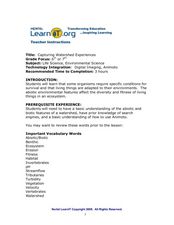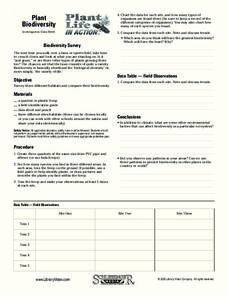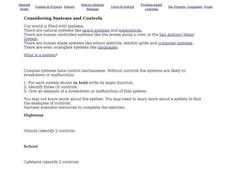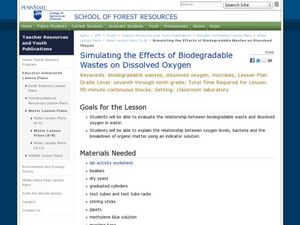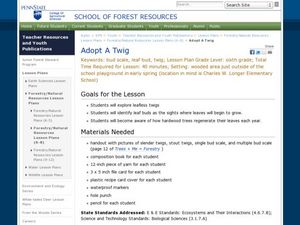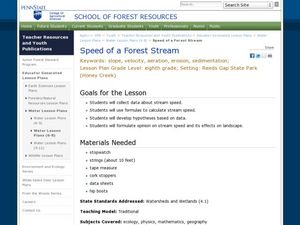Curated OER
Capturing Watershed Experiences
Students observe organisms found in the water. In this lesson on organisms, students collect water from local streams and tributaries in order to study the organisms found in the water. As a culminating activity, students create a...
Curated OER
Plant Life in Action
Sixth graders examine various habitats and record the living creatures they found. In this biodiversity activity, 6th graders complete a worksheet recording their observations. Students draw conclusions about the climate and its effect...
Curated OER
Guetemala's Changing Forest
Eighth graders compare their local ecological zone to the tropical rainforest. In this natural ecology lesson, 8th graders complete an activity about the differences in ecological zones. They compare their biome to the Guatemalan...
Curated OER
And Then there Were Nun: Trees that could be endangered by the Nun Moth Invasion
Learners read and article and become familiar with the danger to trees from the Nun Moth. For this Nun Moth lesson, students work in groups to create visual images of vocabulary words. Learners reflect on the article by assessing the...
Curated OER
Considering Systems and Controls
In this systems and controls worksheet, students write the major function, identify three controls, and give examples of each system. Students do this for highways, school, desert ecosystem, and communication.
Curated OER
Breaking News English: Protecting Antarctica from Tourism
In this Antarctica worksheet, students read the article, answer true and false questions, complete synonym matching, complete phrase matching, complete a gap fill, answer short answer questions, answer discussion questions, write, and...
Curated OER
Plankton / Phytoplankton
Learners discuss the importance of plankton in the ocean ecosystem. For this biology lesson, students identify the different types plankton by observing them under the microscope. They explain how plankton population affect global climate.
Curated OER
Ecological Pyramids
Students apply the ecological pyramids of numbers and biomass with an activity using topographic maps. In this trophic level lesson, students work in groups using a topographic map to determine the number of organisms that can live in an...
Curated OER
Simulating the Effects of Biodegradable Wastes on Dissolved Oxygen
Students evaluate the relationship between biodegradable waste and dissolved oxygen in water. In this biodegradable wastes lesson students complete a lab activity in groups then analyze their results.
Curated OER
Adopt A Twig
Sixth graders explore leafless twigs and identify leaf buds. In this forest resources lesson students complete a lab activity that shows them how to identify tree and leaf identification.
Curated OER
A Walk in the Woods
Eighth graders observe and identify the different levels of the forest. In this forest zones lesson students observe, identify and name a variety of forest components and describe how humans impact the forest ecosystem.
Curated OER
The Sonoran Desert
Little learners examine a map of the southwestern United States and identify the Sonoran Desert. They locate different cities and rivers, determining whether or not each is found within this special ecosystem. A student handout is...
Curated OER
Speed of a Forest Stream
Young scholars study stream speed. In this stream speed lesson students complete an activity and formulate an opinion and study its effects.
Curated OER
Leaf Arrangement: Kinetic Cognitive Connections
Students use critical thinking to identify leaf patterns. In this problem solving activity, student compare leaf patterns by "acting out" the positions and structures they see. This is a kinetic lesson where concepts are attained through...
Curated OER
Sea Level Trends ~ Ocean Front Property: An "Immerging" Market
Young oceanographers take a look at sea level data from several cities over a few centuries. They use the data to fuel a discussion about what kind of changes are taking place and the impact they are having on the coastal ecosystems....
Curated OER
Water Quality
Students examine water quality and how to improve it, how to measure it and how it relates to human activities. In this water quality lesson students sample water from different sources, and test the samples.
Curated OER
Must We Shoot Bambi?
Students explore the deer population. In this environmental instructional activity, students participate in a hands-on activity to better understand the concept of controlling the deer population.
Curated OER
Groundwater as Part of the Water Cycle
Ninth graders study the effects of soil and rocks on filtering groundwater. In this groundwater lesson students complete a lab activity that includes sources of contamination.
Curated OER
White-tailed Deer Issues
Ninth graders examine the white tail deer population in Pennsylvania and explore the impacts that the deer have on the flora and fauna. For this white-tail deer lesson students complete an activity and graph their results.
Curated OER
Earth Water Distribution and Water Consumption
Students explore the need for conserving fresh water and understand that it is a limited supply. In this water consumption lesson students participate in an activity and answer questions.
Curated OER
Identifying Pennsylvania Watersheds
Ninth graders study and identify the six major drainage systems in Pennsylvania. In this watershed lesson students read an article, complete an activity and take a quiz on what they learned.
Curated OER
"Potato Mountain": Reading/Understanding Topographic Maps
Students investigate how to read topographic maps. In this map reading lesson students complete a topographic map activity.
Curated OER
Is there a Doctor in the Treehouse?
Pupils investigate the afflictions of trees and compare the health of a human to that tree. In this tree lesson students complete an activity and create and present a report.
Curated OER
Steps for Taking a Cutting for Your Own Forest at Home
Students study renewable and nonrenewable resources and take a hardwood cutting. In this hands on activity students learn what rooting hormones are, how they generate roots and then take their own cutting and root it.


